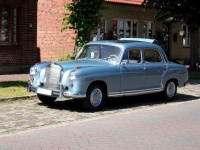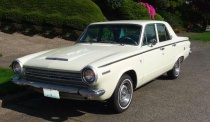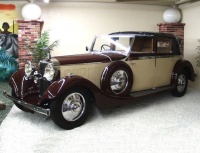Chapter 11
- Please keep these annotations SPOILER-FREE by not revealing information from later pages in the novel.
Page numbers refer to editions with 369 pages, where the story begins on page 1. Not sure if there are other editions with variant pagination. Please let us know otherwise.
Contents
Page 163
Petit Larousse
A French-language encyclopedic dictionary, still in use today. Not really much else to it. Perhaps the reference is merely an insight Doc's character, walking a fine line between educated and dopey.
Page 166
Brylcreem
Brylcreem is a hair styling oil/gel for men that was very popular. It gives hair a wet, oily look.
on the natch
"natch" is short for "natural" and "on the natch," in this context, means sober. On pg. 273, the perennially sober Bigfoot is described as a "literal-minded natch-meister."
Page 168
Leuzinger High
A real high school, in Lawndale, California, which - particularly in the story's time period - was a relatively undesirable and low-priced city in the LA area.
Dr. Blatnoyd
Probably a play on the term of Russian origin, meaning a man with underworld connections or a career criminal.
Page 169
Foreign Affairs, Sinsemilla Tips, Modern Psychopath, Bulletin of the Atomic Scientists
Foreign Affairs is a real (and highly-respected) journal, as is Bulletin of the Atomic Scientists; the other two are fake. Sinsemilla is a highly potent form of marijuana obtained from unpollinated female plants. Modern Psychpath is probably a takeoff on either Modern Psychoanalysis or (Journal of) Modern Psychology, both real journals.
Page 170
Section Eight hippies
Section Eight is low income housing funded with a federal subsidy.
Section Eight was also the military term for mentally unfit to serve, as veterans of "McHale's Navy" or "M*A*S*H" might recall, and it may sum up the Golden Fang view of people like Doc.
Page 171
Japonica Fenway
"Japonica" is just a Latinization of "Japanese," but it is most commonly used in formal Latin plant names. There are a wide variety of "____ Japonica" plants, such as the Camellia Japonica. While it's not really possible to make any universal statement about such widely varied species, they tend to be ornamental and hardy. See: Plants of Inherent Vice
Crocker Fenway
It is possible the first name is inspired by the character "Crocker Jarmon" from the movie The Candidate (1972). The character in the movie is an establishment, incumbent GOP Senator from California.
The first names of both characters may also refer to Crocker National Bank, which historically was a conservative, Republican institution. 1936 Time Magazine reference, 1986 Article.
though Doc may once have rescued Japonica
Reminiscent of Carmen Sternwood, the unstable babe in Raymond Chandler's The Big Sleep (1939), and her rescue by detective Philip Marlowe. There was a wealthy father there, too.
the ancient American Indian belief that if you save somebody's life, you are responsible for them from then on, forever
Last seen in Against the Day with Foley Walker and Scarsdale Vibe.
Page 172
Governor Reagan
Ronald Reagan was governor of California from 1967 to 1975.
Page 174
like the star-shaped blades in kung fu movies
Star-shaped blades are one form of the Japanese shuriken, the best-known form in the Western world but by no means the most common back when they were in actual use. Shuriken were used by ninja and other Japanese warriors. Kung fu is Chinese and does use throwing weapons, but they usually look like darts, coins, forks or knives. While nothing forbids a kung fu practitioner from using a star-shaped throwing weapon, associating the two looks weird.
"Miss Fenway," the doctor began to explain, "may seem a little psychotic today..."
Reminiscent of the psychodontist, Dr. Dudley Eigenvalue, in V. From page 138 of that book (the beginning of chapter seven): "Back around the turn of the century, psychoanalysis had usurped from the priesthood the role of father-confessor. Now, it seemed, the analyst in his turn was about to be deposed by, of all people, the dentist." In general, "Smile Maintenance," at least as practiced by Dr. Blatnoyd, seems to cover some mixture of dentistry, psychology, and "hoddible fucking!"
Page 175

Mercedes sedan
ten-year-old Mercedes sedan with a roof panel
late rush-hour traffic
Should be afternoon, the thirteenth day of the narrative, Sunday, April 5, 1970, but why would there be rush hour traffic? Why would postcards be delivered today, and why would the Golden Fang be open?.
Page 176
outdoor concerts where thousands . . . public self
A good description of Woodstock, which had just taken place the previous year.
each person was listening in solitude, confinement and mutual silence
Perhaps a foreshadowing of the iPod generation?
headphones!
Here, "head" refers to a drug user, as in "head shop".
Doc noticed (a) it was now dark
Should be evening, the thirteenth day of the narrative, Sunday, April 5, 1970.
Page 180
Things were weird for a few days with the Dart
The timeline gets broken here. From the end of the book to this point--from April 26 to May 8--the narrator has made it easy to follow the events of the book in real time. The narrator puts Doc to bed at night, gets him up in the morning, points out television shows and events.
The first half of the book, thirteen days up to the "few days" the Dart was in the shop, can also be matched with real time events. For example, Doc's parents visit during a division semifinal game between the 76ers and the Bucks. That series was played from March 25 to April 3. That would mean that the Dart was in the shop for a couple of weeks. Given the regret that Doc felt over a less-than-24-hour delay in the first and second days of the narrative, it's difficult to believe that he would drop the case for that long. Perhaps some kind of Dark Shadows parallel time is at work.
Or maybe Pynchon, contrary to reputation but like most authors, hasn't been perfectly careful about the relationship between his story's timeline and the real calendar's.
When he finally went over to pick up his ride
Probably morning, Saturday, April 25, 1970. See below for an explanation of "probably". The obvious reference is to the resurrection of Jesus Christ, who also came back on a Sunday. This is not Easter Sunday, though. It occurred on March 29 in 1970.
Page 181
Quonset hut
Prefabricated metal building with a semicircular cross section. Wikipedia
'64 Dodge Dart

Page 182
I'll buy you lunch
Probably morning, Saturday, April 25, 1970. I say probably because it seems unlikely that Doc could have lunch with Tito, make a few phone calls, and drive to Ojai, getting there before lunchtime. The narrator has been pretty careful, though, from the end of the book to this point in noting the ends and beginnings of days.
They went down Pico . . . before repeating an ethnic category.
A possible nod to noted LA chowhound Johnathan Gold, who got his start as a Pulitzer Prize winning food critic eating his way across ethnic LA along Pico Blvd. Profiled here on NPR's "This American Life" (See: Act Five. Taste.)
Page 184
D and D, Tito
Deaf and Dumb, i.e., my lips are sealed...
1934 Hispano-Suiza J12

Page 185
Gold fang
According to Google language tools, the modern Greek for "gold tooth" would be pronounced "chrysó dónti".
The tooth Tito indicates is a canine, and "skylos" means dog, so the word is chrys + skyl + odon. When Tito says "it's squashed together a little" he's referring to loss of an "s" — "chrysoskylodon" would be a more standard combination.
| Chapter 1 pp. 1-18 |
Chapter 2 pp. 19-45 |
Chapter 3 pp. 46-49 |
Chapter 4 pp. 50-54 |
Chapter 5 pp. 55-67 |
| Chapter 6 pp. 68-88 |
Chapter 7 pp. 89-110 |
Chapter 8 pp. 111-123 |
Chapter 9 pp. 124-153 |
Chapter 10 pp. 154-162 |
| Chapter 11 pp. 163-185 |
Chapter 12 pp. 186-206 |
Chapter 13 pp. 207-234 |
Chapter 14 pp. 235-255 |
Chapter 15 pp. 256-274 |
| Chapter 16 pp. 275-295 |
Chapter 17 pp. 296-314 |
Chapter 18 pp. 315-342 |
Chapter 19 pp. 343-350 |
Chapter 20 pp. 351-363 |
| Chapter 21 pp. 364-369 |